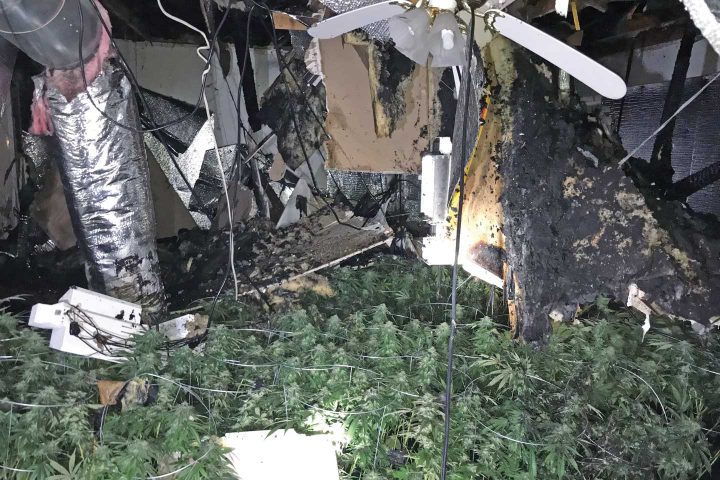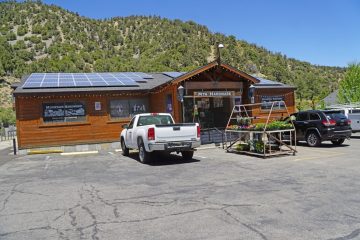This article is part of a series exploring illegal marijuana grows. Read the rest of the series here:
1) Illegal Marijuana Grows: Follow The Water (4/21)
2) Illegal Marijuana Grows: Electric Connections (5/21)
3) Illegal Marijuana Grows: What’s Being Done (6/21)
4) Illegal Marijuana Grows: Intimidation, Harassment & Violence (7/21)
Illegal cannabis or marijuana grows are popping up all over the high desert. It’s not hard to notice the sudden interest in horticulture as you drive through many desert communities in the unincorporated areas of San Bernardino County. While it is fairly easy to spot the large compounds with multiple hoop greenhouses, there is another type of illegal marijuana grow that can slip under the radar of the unsuspecting residents living in these communities. Grow houses are less conspicuous than hoop greenhouse operations and often hard to spot but have the potential to be more deadly to a community than what is grown inside.
A grow house is a property often located in a residential area primarily used to grow and process marijuana or other organic drugs. They are outfitted with hydroponic equipment that provides water and nutrients to the plants, and artificial lighting is used to provide needed “sunlight.” Oftentimes properties are purchased for the sole purpose of growing and cultivating marijuana. Every room in the entire house is converted into what is essentially an indoor greenhouse containing thousands of plants.
Indoor grows require expensive ventilation and exhaust systems, and artificial lighting because they cannot leverage the sun to grow their plants efficiently. Artificial lighting for an indoor grow is costly. According to the 2018 Cannabis Energy Report issued by New Frontier Data, an indoor grow uses almost twice as much power as a greenhouse grow and over 8000% more than an outdoor grow, yes 8000%. These figures are based on reporting from legal cannabis grow facilities that are following regulations and using properly installed equipment.
Growing marijuana indoors or in a greenhouse requires massive amounts of electricity which could easily account for almost half the grows monthly expenses. According to an article published by the National Conference of State Legislatures and written by Jocelyn Durkay and Duranya Freeman (August 2016), the electricity consumption of an average household in Boulder County, Colorado, in 2015 was about 630 kilowatt-hours per month, and a 5000-square-foot indoor grow facility used about 41,808 kilowatt-hours per month. The size of an average house is 2,500 square feet.
There is basically one of two ways to obtain the amounts of energy required by grows. One is from generators and the other from the power grid. Using generators would require large amounts of gasoline or diesel fuel to run generators. In the case of an indoor grow, power is needed 24 hours per day. For greenhouse grows power is most needed through the night if not 24 hours per day.
Getting electricity from the power grid can be risky for these illegal grows. Most houses or properties have meters installed that track how much energy is consumed. If consumption is abnormally high, then a red flag is raised, and the power company can further investigate and or notify the authorities. A common solution for illegal growers is to bypass the service meter, basically connecting the house’s electrical system directly to the powerline servicing the home. Another is by tapping directly into the main service line located near the grow site. This makes it more difficult for power companies to identify where abnormal power usage is coming from.

Bypassing or tapping into power is becoming commonplace with marijuana grows. Nearly every raid the San Bernardino County Marijuana Enforcement Team (MET) makes results in finding that power has been illegally obtained. Stolen electricity from illegal grows typically ranges from tens of thousands to hundreds of thousands of dollars—losses from stolen energy increase operating expenses and the cost of energy for power company customers.
In August 2020, Riverside County Sheriff’s discovered 2.5 tons of marijuana during an investigation of four locations that resulted in the seizure of 4,901 marijuana plants, 110 pounds of processed marijuana, 80 fans, 145 lights, and two air conditioning units. Southern California Edison discovered electricity was stolen via bypass and estimated about $280,000 in electricity had been stolen.
In February 2021, an Apple Valley man arrested after San Bernardino County MET served a search warrant and found 1,907 plants, two pounds of processed marijuana, and about $3000 in cash. An electrical bypass was found, and Southern California Edison estimated the loss of electricity at about $250,000.
In June 2020, after a lengthy investigation, Riverside Police discovered 23 residences operating illegal indoor marijuana grows. They seized 20,000 plants and 100 pounds of processed marijuana. Southern California Edison estimated the total theft of electricity from 15 of the grows to be $1.7 million. However, approximately $1 million was recovered from asset forfeiture.
Another common occurrence is electrical fires associated with the illegal bypass of electricity. They are an extreme fire hazard the can endanger residents and neighborhoods. Electrical shorts caused by bypassed or unpermitted (tapped) wiring could result in explosions or fires affecting neighboring houses. Residences on the same power line could experience an overloaded circuit which could harm electronics and appliances designed to receive a certain steady amount of electricity. Electricity could also, unknowingly, get fed back into the power line, which could pose a danger to linemen, who assume the power line they are working on is de-energized.
As more and more illegal grows move into an area, the potential for power outages increases. Constantly running high-watt light bulbs and ventilation systems can overtax local electric grids and cause neighborhood blackouts. Legal growers will alert the power company of their presence which may result in a separate dedicated circuit being installed to accommodate the increased power needs for that particular operations. Illegal grows are less likely to notify the power company of their increased needs. A director of safety from a power company in Oregon likened the operation of a small indoor grow to “hooking up 29 refrigerators that run 24/7.”
Grow houses may be hard to spot because they don’t want to be spotted. However, there are some key signs that a house may be a grow house, such as a house that has blacked-out or sealed off windows; lights that never change, or constant bright light coming from the edges of the window; unusual activity around the electrical box like wiring that looks out of place; large air ducts and ventilation systems; a strong skunky odor coming from the house; an unusual amount of visitors going into and out of the home; frequent loading and unloading of materials in the garage; Security bars over the windows and surveillance cameras or even baby monitors; a humming sound or sound of generators running through the night; and a lack of snow on the roof, especially when neighboring roofs have snow on them.
It is important to notify the police, fire department, or even the power company if you suspect a grow house; avoid putting yourself in harm’s way.














